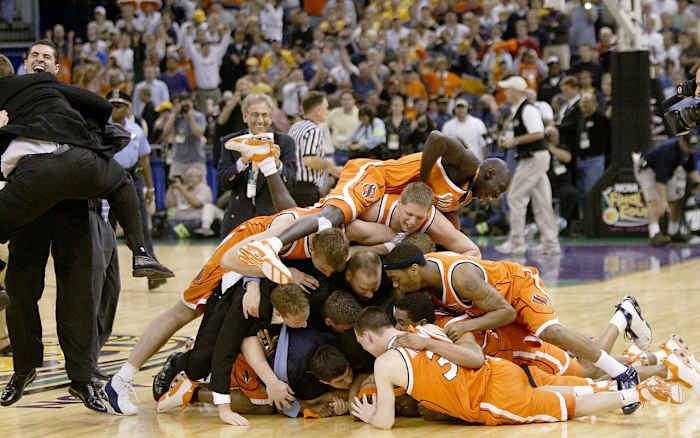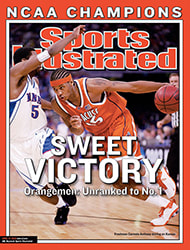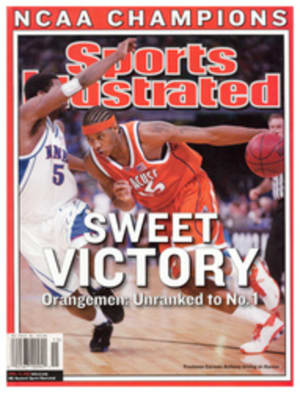Orange Crushed
To be golf coach was best. At Syracuse in the early 1970s, back when the athletic department could justify the salary only by piling additional duties on a graduate assistant basketball coach, Jim Boeheim preferred coaching golf for one reason: No one knew the results unless he phoned them in. Imagine a Final Four that worked that way. No Nantz and Packer; no scrum of coaches in a hotel lobby down the street; no one knowing what happened unless Jim Boeheim called with the news. "That was a lot more fun," Boeheim said last week, recalling his golf-coaching days. "Everyone thought we were undefeated." ¶ No one had that misapprehension about the two Syracuse teams Boeheim took to the Final Four before this year, especially the one he brought to New Orleans in 1987. The world knows that the Orangemen had been on the business end of Keith Smart's shot with four seconds to play, the jumper that won Indiana an NCAA title. It took years for Boeheim to get over the pain of that loss, and the game tape remains the only one he has never watched. "I wish we'd have won that game, but would my world really be different if that shot hadn't gone in?" he asks. "I don't think so. I never thought Marv Levy would have been a better coach if he'd won one of those Super Bowls."
Boeheim was no better a coach by the end of this season, even after squeezing all he could out of a one-year wonder of a freshman named Carmelo Anthony, including Monday night's 81-78 defeat of Kansas in the Superdome for the NCAA title. He might, however, have been a different man. According to his wife, Juli, he had never before told one of his players "I love you," as he did to Anthony, a 6'8" forward, after the Orangemen qualified for New Orleans with their East Regional defeat of Oklahoma.
And what's not to love? From his sweet dish to center Craig Forth for the first basket of the title game, to his graceful pirouette while calling timeout in the final minute as Syracuse clung to a lead, to his 20 points, 10 rebounds and six other assists, Anthony embodied the credo tattooed to his right biceps, LIVE NOW/DIE LATER. "Ain't nothing left for him to do," said Anthony's brother, Justus, in the postgame tumult.
Nor, it seems, is there much left for his coach to accomplish after 27 years. "There's four seconds he has to clean up," Kueth Duany, Syracuse's lone senior regular, said of Boeheim last week, before Anthony and fellow freshman Gerry McNamara delivered the title by playing with more poise than the Jayhawks' senior leaders, Nick Collison and Kirk Hinrich. "Those are the four seconds we're trying to get for him." And get them these unlikely champions did, replacing four final seconds with a Final Four first.
Much of the Syracuse narrative leading up to Monday night had been delivered by television, and for almost a quarter century that story line had been, alternately, boon and bane. During the 1980s and into the '90s, ESPN's images of a full Carrier Dome served as recruiting infomercials, particularly effective in Southern California, where impressionable high school stars, home from practice and waiting for dinner, would tune in. Many wound up making the surprising decision to go where winters are long and the local industry is air conditioning. At the same time, sideline cutaways always seemed to show Boeheim in full caterwaul, and to judge by his expression and body language, he liked neither people nor life, much less basketball, thereby establishing his reputation as a grouch and a yokel. (He didn't do much to dispel it. Asked once why he so rarely took his teams to tournaments in Hawaii, he said with a harrumph, "Ah, Hawaii. Syracuse in July.") Boeheim had also mined New York City for recruits, like the playmaker Dwayne (Pearl) Washington, maestro of those teams in the early '80s. But the next great Gothamite point guard to come along, Kenny Anderson, chose Georgia Tech. A comment attributed to a member of Anderson's family may be apocryphal, but it had the ring of an epitaph: "That city's cold, and that man is, too."
Still, Boeheim carried on. He earned the respect of other coaches with his 20-win seasons--25 in all--and his feel for the game, especially in learning and incorporating its many styles. "He's very dangerous once they throw it up, because he sees the game globally," says Dave Gavitt, the founding commissioner of the Big East, the conference that gave Boeheim the national stage upon which he seemed so uncomfortable, especially alongside such outsized coaching personalities as John Thompson, Lou Carnesecca and Rollie Massimino. But, as Gavitt says, "Jimmy's a very provincial guy, and all of a sudden his world was national." And although no Division I coach has been in the same place longer than Boeheim, other schools never really tried to hire him away. He attracted plenty of talented players, yet among NBA scouts they had a reputation for not always developing and not always practicing hard. Syracuse, you could say, was the UCLA of the East.
Then Jules met Jim. With a gesture as old-fashioned as a blue blazer or a 2-3 zone, Boeheim caught the eye of a stunning Kentuckian some 20 years younger, Juli Greene. At a Derby party in Louisville in 1995, she had returned from the ladies' room to find her spot on the sofa taken. Boeheim created a place for her and pulled up a chair. They fell into conversation, then a game of backgammon; he rebooked his flight to stay another day, and she taught him how to dance the two-step. A year and a half later, after he had dropped to one knee in the laundry room of his Syracuse home to ask if she would marry "this old stiff," she did.
Boeheim had grown up in the upstate New York town of Lyons, the son of an undertaker. The family home doubled as a funeral parlor, and little Jimmy quickly learned that it was good business to subordinate one's emotions to those of the family's customers. The critical point here is that Boeheim wasn't emotionally one-dimensional all those years; he was just raised to be opaque with his feelings. "He's basically a very shy guy who's finally reached a comfort level," Gavitt says.
"Everybody says that Jim has changed so much, but he really hasn't," Juli says. "What the public is starting to see now is the only Jim I've ever known."
Boeheim remains friendly with his first wife, Elaine, and their adopted daughter, Elizabeth, 17, who live in Syracuse not far from Jim and Juli and their three kids, Jimmy, 4, and three-year-old twins Jamie (a girl) and Jack. Nearly every day the two boys push aside the dining-room furniture for a hoops game of their own devising, Starting Lineup, in which one plays for Syracuse and the other for some NBA team. Their 58-year-old dad may play a little defense or even cheer one of the boys' moves. But he's never a coach. "I'm always the coach at home," says Juli, a remark that's worth reading at more than one level.
A year ago Boeheim underwent treatment for prostate cancer, the disease that had taken his father's life, but long before that he was involved in the Coaches vs. Cancer charity. It's a cause that fits perfectly with Juli's Bluegrass hostessing skills, and together the Boeheims help stage the black-tie Basket Ball, an annual gala that accounts for Syracuse's easily leading all schools in raising funds for that organization. Only a few weeks ago he and the team taped a promotional spot for this year's event, which is set for April 26 and will feature the Temptations. Boeheim opens the promo with a spiel, then adds some Motown choreography. His players, unprepared for a Temps-style spin move, dissolved into such hysterics that the director couldn't use the take, and this upset Boeheim, who insists that his best move wound up on the cutting-room floor. "I used to tell him that there'd be no name on his tombstone, just a caricature of him with his glasses hanging on his nose," says Gavitt, mimicking the Boeheimian sourpuss expression with arms imploringly outstretched.
The current Orange players, of course, know only one Boeheim, and it's not the misanthrope of Big Mondays past. "I heard he used to throw chairs in the locker room," says Forth. "But he hasn't thrown one since I got here. And when he does get on you, it gets you motivated. You want to win for him--sometimes just to prove him wrong, but sometimes just to make him happy."
The team made him happiest with how it played the 2-3 zone, which is nothing like that Mickey Mouse setup you'll recall from CYO days. Today Syracuse looks for long-armed, long-bodied players with quickness and skills--such as 6'8" sophomore forward Hakim Warrick--and those physiques lend themselves to an effective 2-3.
In the East Regional final the 2-3 so flummoxed Oklahoma that the Sooners had more turnovers (19) than baskets (18). In last Saturday's 95-84 semifinal defeat of Texas, the top of the zone dared T.J. Ford to shoot, and when the Longhorns' point guard penetrated, the back line cheated forward enough to keep him from probing deep into the lane. "I played a lot of zone in high school, but there's no zone like this," says Warrick, who made the crucial block of Michael Lee's last-second three-point attempt in Monday's final. "You'd never think there's this much to it. It's like a 400-level class."
Because zones are so rare these days, most teams don't have highly refined offenses to run against them. "You have to make shots against a zone," says Gavitt. "And to get good shots, you have to pass the ball with some imagination. Kids today can do just about everything better than in the old days except passing. So if you throw a zone out there and it's active and working, a lot of teams can't make you pay."
Moreover, the zone may surrender shots, but often in unaccustomed places, like the midrange. And while so many teams avoid playing the 2-3 for fear of giving up the three-point shot, Syracuse will sometimes extend on the wings, inviting opponents to prove that they can consistently get the ball in the foul circle and sink that simpler, but less damaging, two-point shot or make a high-low pass for a layup.
Yet even his great tactical creation has brought Boeheim as much grief as praise. "I'm still doing the same things," he says. "We just have better players this year. It's funny: If we lose, it's always that we shouldn't be playing the zone. You lose with a man-to-man, it's somehow better."
The Orange sometimes even traps out of its zone, nowhere more effectively than in the "short corner," the horse latitudes where the foul lane meets the baseline. Opponents who pick up their dribble there may find themselves looking beseechingly at a pom-pom girl, the only friendly face they can find. Eventually, opposing players get what Duany calls "the bug-eyed look ... like they're lost and confused."
That described Syracuse a year ago, when discipline problems and dissension tore the team apart. Boeheim pronounced it his most difficult season as a coach, quite apart from his bout with cancer. The departure of three players created room for a scorer and a floor leader, roles that Anthony and McNamara, respectively, have assumed. Given their transforming influence on the team, those two aren't freshmen so much as refreshmen. "I've never seen Jim have so much fun with a team," says Juli. "Last year the phone would ring, and you'd know it wasn't good. This year those calls never came."
Not that the season passed without its dodgy moment. Credit Boeheim with a deft bit of peacemaking in January, shortly after the return of first-year guard Billy Edelin, who had been suspended for 12 games by the NCAA for playing in an unsanctioned summer league. Edelin feared that McNamara had claimed his minutes. Anthony didn't think McNamara was getting him the ball enough, and he was bugged that the press was making such a big deal over Edelin's arrival. Boeheim spoke with all three individually, then gathered them in his office to bring them together. "After that meeting our roles were clear," says Edelin.
Anthony and McNamara combined for 38 points and nine three-pointers against Kansas, including six three-pointers by McNamara in the first half. "We tried not to double off McNamara," Collison said after the title game, "but when Anthony gets the ball, everyone's got to give help."
"They make a mistake here and there," Boeheim said of his freshmen after they beat Texas, "but these kids are young enough to think they can do anything, and I'm not going to tell them differently."
McNamara will remain an Orangeman for three more years. The only question surrounding Anthony's future, after the NBA-style clear-outs with which he dominated both games last week to win the Most Outstanding Player award, is whether he may now be threatening LeBron James's status as the likely No. 1 pick in the June draft. For all the skills he showcased over the weekend-feathering jumpers, plucking rebounds, finding teammates and, yes, laying Temps-style spin moves on Kansas forward Keith Langford--the lasting image of Anthony may be one that captured his unburdened attitude. Late in the first half he stood in front of the scorer's table, waiting to check in, smiling and waving two towels as the Syracuse lead crested at 18. Coaches are from Earth; players are from Pluto.
As for the Mars-and-Venus Department, there's this to report from Monday night: Before One Shining Moment could be piped through the Superdome's P.A. system, Boeheim turned to his wife, said "Let's go home" and tried to lead her into the tunnel. To which Juli replied, "This is my favorite part. We can't go yet." And he stayed.
In the end, even as Carmelo Anthony departs, isn't that the epitaph Jim Boeheim deserves? HE STAYED. Indeed, Syracuse's only unexpected phone call this season will be the call in which Boeheim phones in the score to the fates.


